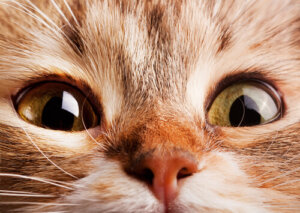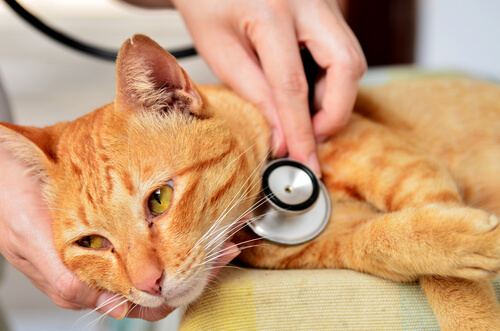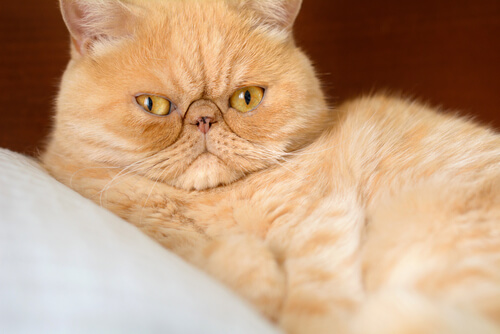What Causes Rapid Breathing in Cats?


Written and verified by biochemistry Luz Eduviges Thomas-Romero
All vertebrates require oxygen to carry out their vital functions and they obtain it through a process known as respiration, either underwater or on land. Felines are no exception and must continuously obtain air in order to oxygenate all the tissues of their body. Consequently, the respiratory rate is a reflection of the animal’s state of health and metabolic demand. Find out about the causes of rapid breathing in cats in today’s article.
To detect accelerated breathing in cats, you need to know what the normal respiratory rate would be. It’s quite normal for your cat to pant or breathe a little faster than normal if it’s just had a play session or been running. However, if in doubt, we’ll tell you how to check the breathing rate in cats – it’s very simple.
How to detect rapid breathing in cats?
First of all, you should know that a cat’s normal breathing rate is between 15 and 30 breaths per minute. It’s also important to carefully observe the cat’s environment and body language, because in natural conditions the respiratory movement should be smooth, uniform, and without physiological restrictions that are evident.
To determine your cat’s respiratory rate you should count the number of breaths your cat takes in a 60 second period. This can be easily accomplished by direct observation.
Ideally, you should check the respiratory rate several times to obtain an average rate (add up all the measurements and divide by the total number). Breaths can vary and an overall average will be more accurate. Keep in mind that if your cat is stressed their rate may be higher than normal at a particular time, so wait a few minutes or hours between measurements.
When should you be concerned?
As the VCA Hospitals website states, there are many medical signs that indicate that something may be wrong with your cat’s health if it’s breathing faster than normal (a phenomenon known as tachypnoea). Here are some other signs that warrant a visit to the vet:
- Rapid breathing at rest or sleep (more than 30 cycles per minute)
- Increased breathing effort during the ventilatory cycle, known clinically as dyspnea – it may occur along with tachypnea
- Anxiety, agitation, and difficulty finding a comfortable sleeping position
- Changes of position during rest
- Coughing, spitting, rales (crackles) and ejection of foreign substances through the mouth
- General weakness
- A reluctance to do exercise
- Collapsing and sporadic unconsciousness
- Weight loss
- Abdominal distention
- A lack of interaction with the owner.
All of these symptoms are indicative of a heart or respiratory problem in dogs, cats, and other mammals. However, some clinical signs are unique to felines. These include lameness in the hind legs, paralysis in the posterior third of the body, difficulty moving the forelimbs, and generalized pain.

If breathing is very slow, you should also consult your veterinarian.
Common causes of fast breathing in cats
There are literally dozens of reasons why your cat might have trouble breathing. Some of the most common include infections, tumors, enlarged heart, fluid in the lungs, bleeding in the lungs, asthma, allergies, traumatic injuries, paralyzing toxins, and a low red blood cell count.
To determine the cause, you need to take your cat to the vet quickly. They’ll begin a series of tests that may include a blood count, biochemical profile, urinalysis, and perhaps even an electrocardiogram. Ultrasounds, x-rays, and other imaging techniques may also be necessary to take a look at the animal’s internal organs.
Depending on what they find, they may ask for an x-ray or ultrasound to take a look at your cat’s heart or lungs. They may even need to insert an endoscope into your cat’s nose or airway to find out if something is wrong. The vet will closely monitor your cat’s breathing to make sure they’re getting adequate oxygen.
Infection as a cause of rapid breathing in cats
The main cause of breathing difficulties is respiratory infections caused by one or more viral or bacterial agents. This occurs mostly in cats that are regularly taken outdoors and in cats that aren’t vaccinated as kittens. The next two points to highlight in this topic are the following:
- The most common viruses that cause upper respiratory tract infections in cats are feline herpesvirus type 1, also known as feline viral rhinotracheitis or VFR, and feline calicivirus (FCV). Some vaccines, such as Felocell®, protect against these and other pathogens.
- On the other hand, the most common bacteria that cause upper respiratory tract infections in cats are Bordetella bronchiseptica (Bronchiseptica) and Chlamydophila felis (C. felis). Although these conditions can’t be prevented with vaccines, antibiotics will help to reduce symptoms in a matter of days.
Heart disease as a cause of rapid breathing in cats
While the most common cause of upper respiratory illness in cats is viral disease, other causes, such as a heart condition, also need to be considered. If the respiratory rate is increased when the cat is resting or sleeping – more than 30 breaths per minute – heart issues should be suspected.
It’s important to observe if the rapid breathing is accompanied by any of the following clinical signs: coughing or retching, restlessness, agitation, and difficulty finding a comfortable sleeping position, weakness, or decreased appetite. These are some of the heart conditions that can affect cats:
- Hypertrophic cardiomyopathy (HCM): This disease is characterized by a gradual thickening and weakening of the heart muscle. As the heart muscle thickens, there’s less room for blood to fill the heart and it’s less able to pump blood effectively.
- Dilated cardiomyopathy (DCM). In this case, the heart muscle is weak and thin. Long ago, this pathology was attributed to the absence of taurine in the feline’s diet, but these days cases continue to be diagnosed when this nutrient is present in all cat food.

Other factors to consider
Cats with characteristics such as short or contoured nasal cavities or very small nostrils are predisposed to unresolved airway inflammation. In terms of age, cats of all ages can be affected. Mental health factors such as anxiety should be contemplated, although they aren’t the main trigger for tachypnea.
Finally, if you’re concerned about rapid breathing in cats and no apparent cause is found, you should be aware that it can also be caused by fungus. However, fungal disease is more relevant in specific geographic regions. For this reason, the inclusion of the cat’s travel history is important in the medical history.
All vertebrates require oxygen to carry out their vital functions and they obtain it through a process known as respiration, either underwater or on land. Felines are no exception and must continuously obtain air in order to oxygenate all the tissues of their body. Consequently, the respiratory rate is a reflection of the animal’s state of health and metabolic demand. Find out about the causes of rapid breathing in cats in today’s article.
To detect accelerated breathing in cats, you need to know what the normal respiratory rate would be. It’s quite normal for your cat to pant or breathe a little faster than normal if it’s just had a play session or been running. However, if in doubt, we’ll tell you how to check the breathing rate in cats – it’s very simple.
How to detect rapid breathing in cats?
First of all, you should know that a cat’s normal breathing rate is between 15 and 30 breaths per minute. It’s also important to carefully observe the cat’s environment and body language, because in natural conditions the respiratory movement should be smooth, uniform, and without physiological restrictions that are evident.
To determine your cat’s respiratory rate you should count the number of breaths your cat takes in a 60 second period. This can be easily accomplished by direct observation.
Ideally, you should check the respiratory rate several times to obtain an average rate (add up all the measurements and divide by the total number). Breaths can vary and an overall average will be more accurate. Keep in mind that if your cat is stressed their rate may be higher than normal at a particular time, so wait a few minutes or hours between measurements.
When should you be concerned?
As the VCA Hospitals website states, there are many medical signs that indicate that something may be wrong with your cat’s health if it’s breathing faster than normal (a phenomenon known as tachypnoea). Here are some other signs that warrant a visit to the vet:
- Rapid breathing at rest or sleep (more than 30 cycles per minute)
- Increased breathing effort during the ventilatory cycle, known clinically as dyspnea – it may occur along with tachypnea
- Anxiety, agitation, and difficulty finding a comfortable sleeping position
- Changes of position during rest
- Coughing, spitting, rales (crackles) and ejection of foreign substances through the mouth
- General weakness
- A reluctance to do exercise
- Collapsing and sporadic unconsciousness
- Weight loss
- Abdominal distention
- A lack of interaction with the owner.
All of these symptoms are indicative of a heart or respiratory problem in dogs, cats, and other mammals. However, some clinical signs are unique to felines. These include lameness in the hind legs, paralysis in the posterior third of the body, difficulty moving the forelimbs, and generalized pain.

If breathing is very slow, you should also consult your veterinarian.
Common causes of fast breathing in cats
There are literally dozens of reasons why your cat might have trouble breathing. Some of the most common include infections, tumors, enlarged heart, fluid in the lungs, bleeding in the lungs, asthma, allergies, traumatic injuries, paralyzing toxins, and a low red blood cell count.
To determine the cause, you need to take your cat to the vet quickly. They’ll begin a series of tests that may include a blood count, biochemical profile, urinalysis, and perhaps even an electrocardiogram. Ultrasounds, x-rays, and other imaging techniques may also be necessary to take a look at the animal’s internal organs.
Depending on what they find, they may ask for an x-ray or ultrasound to take a look at your cat’s heart or lungs. They may even need to insert an endoscope into your cat’s nose or airway to find out if something is wrong. The vet will closely monitor your cat’s breathing to make sure they’re getting adequate oxygen.
Infection as a cause of rapid breathing in cats
The main cause of breathing difficulties is respiratory infections caused by one or more viral or bacterial agents. This occurs mostly in cats that are regularly taken outdoors and in cats that aren’t vaccinated as kittens. The next two points to highlight in this topic are the following:
- The most common viruses that cause upper respiratory tract infections in cats are feline herpesvirus type 1, also known as feline viral rhinotracheitis or VFR, and feline calicivirus (FCV). Some vaccines, such as Felocell®, protect against these and other pathogens.
- On the other hand, the most common bacteria that cause upper respiratory tract infections in cats are Bordetella bronchiseptica (Bronchiseptica) and Chlamydophila felis (C. felis). Although these conditions can’t be prevented with vaccines, antibiotics will help to reduce symptoms in a matter of days.
Heart disease as a cause of rapid breathing in cats
While the most common cause of upper respiratory illness in cats is viral disease, other causes, such as a heart condition, also need to be considered. If the respiratory rate is increased when the cat is resting or sleeping – more than 30 breaths per minute – heart issues should be suspected.
It’s important to observe if the rapid breathing is accompanied by any of the following clinical signs: coughing or retching, restlessness, agitation, and difficulty finding a comfortable sleeping position, weakness, or decreased appetite. These are some of the heart conditions that can affect cats:
- Hypertrophic cardiomyopathy (HCM): This disease is characterized by a gradual thickening and weakening of the heart muscle. As the heart muscle thickens, there’s less room for blood to fill the heart and it’s less able to pump blood effectively.
- Dilated cardiomyopathy (DCM). In this case, the heart muscle is weak and thin. Long ago, this pathology was attributed to the absence of taurine in the feline’s diet, but these days cases continue to be diagnosed when this nutrient is present in all cat food.

Other factors to consider
Cats with characteristics such as short or contoured nasal cavities or very small nostrils are predisposed to unresolved airway inflammation. In terms of age, cats of all ages can be affected. Mental health factors such as anxiety should be contemplated, although they aren’t the main trigger for tachypnea.
Finally, if you’re concerned about rapid breathing in cats and no apparent cause is found, you should be aware that it can also be caused by fungus. However, fungal disease is more relevant in specific geographic regions. For this reason, the inclusion of the cat’s travel history is important in the medical history.
All cited sources were thoroughly reviewed by our team to ensure their quality, reliability, currency, and validity. The bibliography of this article was considered reliable and of academic or scientific accuracy.
- Sykes, J. E. (2001). Feline upper respiratory tract pathogens: herpesvirus-1 and calicivirus. Compendium on Continuing Education for the Practicing Veterinarian, 23(2), 166-175.
- Holst, B. S., Hanås, S., Berndtsson, L. T., Hansson, I., Söderlund, R., Aspán, A., … & Greko, C. (2010). Infectious causes for feline upper respiratory tract disease–a case–control study. Journal of feline medicine and surgery, 12(10), 783-789.
- Dawson, S., & Willoughby, K. (1999). Feline infectious upper respiratory tract disease-an update. In practice, 21(5), 232-237.
- Scherk, M. (2010). Snots and snuffles: rational approach to chronic feline upper respiratory syndromes. Journal of feline medicine and surgery, 12(7), 548-557.
- Home Breathing Rate Evaluation, VCA Hospitals. Recogido a 4 de noviembre en https://vcahospitals.com/know-your-pet/home-breathing-rate-evaluation
This text is provided for informational purposes only and does not replace consultation with a professional. If in doubt, consult your specialist.








